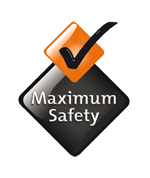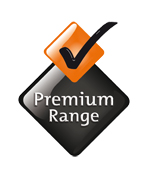You should always keep in mind that a cargo barrier is a safety device. Secondhand cargo barriers have an unknown history and are therefore a risky proposition in any case. The cargo barrier is designed and tested under strict compliance and high impact conditions, therefore in order to maintain the desired performance of the Cargo Barrier, strict adherence to the recommendations of the Australian Standard and our installation instructions is essential. Under no condition do we recommend modification of the product or the use of alternative anchorage points — to do so will void the warranty & rated capacity. Where a Cargo Barrier is modified or a secondhand barrier which is damaged or has an unknown history is fitted, then the rated capacity plaque must be removed and replaced with a non-rated capacity tag by the installer. Failure to remove the rating plaque in these circumstances will result in the product liability transferring from the manufacturer to the retailer / installer of the product.
No.
No.
Very definitely not! Ensure that your Cargo Barrier complies with the Australian/New Zealand Standard AS4034. This Standard is the most rigorous in the world. The current version of this Standard is AS4034.1:2008. Failure to use AS4034.1 rated barriers may put a company executive at risk of prosecution in the event of an accident where an employee is injured. And who wants to live with themselves if their family is injured unnecessarily because a non-complying barrier was purchased?
The Cargo Barrier must have the design strength to remain intact and deform no more than the prescribed amount when a single mass load of no less than 60kg impacts at a force equivalent to that experienced in a 48kmh frontal crash. That’s an impact of 1200kg! Milford Cargo Barriers are rigorously tested in our own NATA approved test facility and independently certified to deliver this Standard for more than 200 Passenger, 4WD and Light Commercial Vehicles.
Cargo Barriers that comply with AS4034.1 are designed to fit specific vehicles. Among the many parameters, they must follow the perimeter of the vehicle, provide uninterrupted access for the seat belt and child restraint straps (this must be built into the barrier and not just provided as an extra cost option) and must provide a means of escape in the event of entrapment. They must be properly secured to the framework of the vehicle using special attachments (rather than the seat belt anchorages).
The Australian Standard rating is extremely severe and in effect the single load mass, is generally considered a worst case scenario. AS4034.1 states: "The test procedure is based on a single mass of cargo placed against the rear face of the cargo barrier. However, research indicates that during collision cargo barriers of any nominal rating may be capable of restraining cargo comprising of a number of smaller items with a total mass exceeding the nominal rating." "The single mass rating simulates the most severe condition and if the cargo were to consist of a number of items of smaller mass, a far greater mass of cargo might be restrained by the cargo barrier. However, because of the variety of cargo compositions possible, the Standard does not specify a rating for such conditions." The important thing is to make sure that you place load against the CB as the effect of NOT putting the cargo against the rear face of the cargo barrier can increase the impact energy that must be dissipated by a factor of up to five times. With the above in mind, if you still consider that the requirements of your organisation are beyond that of our common load rating specifications, please contact us to discuss in detail your needs.
You can tell whether a Cargo Barrier complies with the Standard by looking for the permanently attached Rating Label. The absence of a Rating Label means that the product does not comply at all. A Rating Label that does not state AS4034.1 means that the product may only partially comply and you should ask further questions.
In a side impact situation, Air Curtains are designed to fill an area up to150mm from the internal trim of the vehicle between the roof line and the occupant’s shoulder height within 3 milliseconds and at speeds of up to 320km/hr. For those that wish to fit a Cargo Barrier to a Side Air Curtain equipped vehicle, they should first ascertain whether the Cargo Barrier will provide any obstruction to the successful deployment of the Air Curtain, in all mounted positions. Then ask the question, has the operation of the Air Curtain / Cargo Barrier installation been validated in a test situation and/or does the installation meet with the approval of the vehicle’s manufacturer? Milford engineers work closely with many car companies in an effort to provide a correctly engineered and compatible solution to this issue. As a result, (unlike some of our competitors) we do not include in our application list air curtain equipped vehicles where the CB will come into direct contact with a deployed air curtain . Our research indicates that this has major, potential liability implications for those that specify such an application without the backup of the necessary Engineering, Design, Development, Product Standards and Testing verification required and in all likelihood will result in liability claims in an accident where the air curtain is impeded from working correctly by the existence of a Cargo Barrier.
Of course there is much more, all Milford Cargo Barriers complete a product audit to ensure the best possible fit and function in the vehicle for which they are designed. All Milford Cargo Barriers are then manufactured in our TS16949, ISO9001 & ISO14001 accredited manufacturing facility. In Australia and New Zealand, we are the predominant supplier of Cargo Barriers to car companies and with our Milford brand, the automotive aftermarket. The Milford Cargo Barrier is specified and used by the fleets of Australia’s premier companies.
We recommend that a Cargo Barrier is only installed by a suitably qualified person, Milford provide detailed and complete fitting instructions and conduct training sessions to ensure the best possible installation. All installation components necessary to suit the vehicle model for which the Cargo Barrier is intended must be fully engineered and tested - Milford work closely with car manufacturers to provide the best possible mounting solution.
It can take between one to three hours to install one of our Cargo Barriers depending on the number of mounts and complexity. Once our aftermarket mounting system is installed it generally remains there for the life of that vehicle. The Cargo Barrier is then held into position through the upper and lower mounts. If the barrier requires movement to another location, it’s simply a matter of removing the four fixings attaching the Cargo Barrier to the vehicle & then relocating and re-attaching fixings. This process takes approximately five to ten minutes.
In most cases an aftermarket mounting plate kit is required to safely mount our Cargo Barrier into position. There are some late model vehicles that have been manufactured to incorporate the Cargo Barrier mounts into the vehicle's body structure. Unless existing captive nuts or mounts have been specially designed and tested to withstand the necessary energy levels required to hold back the load and Cargo Barrier in the event of a collision, we recommend that you do not use any other captive nuts or mounts located in the vehicle.
Most of our Station Wagon and 4WD Cargo Barriers are designed for dual position installation. Generally they are designed to locate behind the second row of seats for short loads then may be moved behind the front row of seats for longer loads. This location flexibility helps to protect the occupants in a larger range of situations.
Where ever possible, our Cargo Barriers are designed to fit as close and as safely possible behind the seats of their intended location. Although the Cargo Barrier frame takes up a small amount of space, the load area can be used more efficiently as luggage can be placed all the way up to the roofline.
We do not recommend hanging any items on Cargo Barriers as they can create additional stresses to the Cargo Barrier structure and its mounting points. These additional stresses could affect the correct operation of the Cargo Barrier and its rated performance. We recommend that all items be placed at floor level and as near as practical up against the Cargo Barrier.
If you continually need access from the front passenger section through to the rear load area (e.g. courier work), we have some specifically designed Cargo Barriers that accomodate this function. These are referred to as our “Walk-Through” series and are available to suit a number of popular late model vans. They feature an easy access sliding door that self-closes for your safety.
Our current range of 4WD/SUV and passenger wagon Cargo Barriers have plastic hinged covers (called child restraint devices) included in their package. These child restraint devices are also available individually. Please check with your nearest distributor for price and availability.





